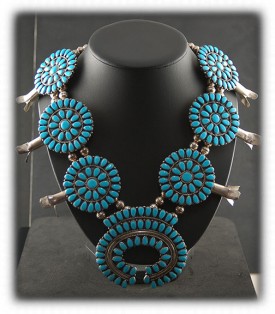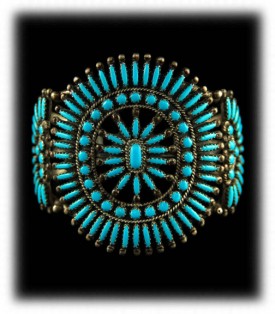Zuni Indian Jewelry Biography
Source(google.com.pk)Zuni Jewelry Directory / Guide for top rated Zuni Silversmiths. These are accomplished Zuni silversmiths who work entirely by hand in silver, gold and rare gem turquoise. The Zuni are noted for their precise turquoise, coral and other gem inlay. It was they who introduced turquoise to Southwest Native American jewelry in the late 1800's. Turquoise inlay jewelry was developed by the Zuni in the early 1900's. Using turquoise, coral, lapis and opal gemstones in Native American jewelry is like adding paints to canvas. Click on the artists name for more information, prices and the artist's bio.
Learning Metalworking Skills
Despite their inherent love of ornamentation and jewelry, the Indians of the Southwest did not learn to work with silver until the latter part of the 19th century. Before that they acquired the few silver ornaments they owned through trade with Hispanic settlers and neighboring Plains Indians. The Plains people had acquired their silver in trade with English, French and American trappers.
One of the first native metalsmiths was a Navajo known as Atsidi Sani who learned, around 1850, to form black metal from a Mexican blacksmith living in the New Mexico territory. In 1853, Indian agent Henry Dodge moved to a house near Fort Defiance and married a Navajo woman. Dodge brought with him a blacksmith and a Mexican silversmith. Years later, after the Navajos were released from their five-year confinement at Fort Sumner, (Bosque Redondo), Atsidi Sani came to the Indian agency to observe the two smiths at work and refine his primitive metalworking skills.
Atsidi Sani taught his four sons to craft silver and they, in turn, taught others. Later, in the 1880s, J.L. Hubbell hired several Mexican silversmiths to teach the craft to Navajos at his trading post in Ganado, Arizona. The Navajos learned to cast silver in sandstone or tufa as well as produce hand-hammered work. Turquoise, a traditional favorite of the Navajos, began to be combined with silverwork in the 1880s. J.L. Hubbell capitalized on its popularity by importing Persian turquoise for trade to the Navajos. Eventually, the local supply of turquoise increased as more mines were opened.
Zuni Jewelry
Metalworking had a different history among the Zuni. In about 1830, the Zuni learned to work with copper and brass salvaged from old kettles. They did not begin silver crafting until four decades later. Around 1872, the Navajo smith Atsidi Chon, who traded frequently with the Zuni for livestock, taught a Zuni blacksmith named Lanyade the skill of silversmithing. Much of the earliest Zuni silver jewelry was essentially identical to Navajo work.
Early Zuni pieces were plain, hand-wrought silver occasionally decorated with simple die-stamping or rocker engraving. Around 1890 they began to include turquoise in their work, as had their Navajo neighbors. Until about 1920, the Zuni fashioned jewelry primarily for themselves and other native peoples. By 1930, the Zuni were creating much of their jewelry for tourists. Within ten years, jewelry making had become a major source or revenue.
The emphasis on small stone work and inlay work began to emerge in the 1920s, developing partly from a revival of prehistoric designs. Today, this style of jewelry, needlepoint, petit poin History of Indian jewellery is as old as the history of the country itself. Around 5000 years ago, the desire to adorn
themselves aroused in people, leading to the origin of jewellery. Since then, Indian women and jewellery have
gone hand in hand. There cannot be a woman in India, who does not adore herself with minimum jewellery. In
fact, jewellery is considered as security and prestige of women in the country. The attraction for jewellery has
been great in India that it is no more a craft than an art.
Indian jewellery is unique in its design and workmanship. In all kinds of traditional dance forms, jewellery has
been a significant part. Be it Bharatnatyam, Kuchipudi or Kathak, all have given importance to jewellery in
presenting the artist. The sheer number of items forming the jewellery of an Indian woman is numerous, ranging
from earrings and necklaces to pieces for adorning the hair, hip, feet, and feet. Jewellery made with emeralds,
diamonds, pearls, rubies, sapphires and other precious and semi-precious stones have been in practice for long.
The range of jewellery in India varies from religious to purely aesthetic types. It is crafted not only for humans, but
also for the Gods, ceremonial elephants and horses. Royal class people have given patronage to the art of
jewellery since ancient times, when rajas and maharajas vied with each other to possess the most exquisite and
magnificent pieces. Regional differences can be observed in the making of jewellery, depending on the
differences in geography, people, culture, and their lifestyle.
While the designs in solid gold jewellery of Tamil Nadu and Kerala are inspired by nature, the Meenakari and
Kundan styles of jewellery making have been influenced by the Mughal dynasty. Then there is a huge range of
silver beads found all over India, especially in Rajasthan, Gujarat, Madhya Pradesh and Himachal Pradesh. Their
availability leads to the development of the bead jewellery, popular till date.
While Assamese jewellery is influenced by local flora and fauna, Manipuri jewellery-makers make use of items
like shells, animal claws, teeth and precious and semi-precious stones. These huge varieties of ornaments bear
testimony to the excellent skill of the jewellers and craftspeople of the country. Indian jewellery in Gold,
diamonds, silver, sterling silver, precious stones, copper and semi-precious stones is a rage all over the world.
Zuni Indian Jewelry Indian Jewelry Sets Bangles Rings Box Designs Band Designs Lates Gold Earnings Designs Ads Photos Images Pics

Zuni Indian Jewelry Indian Jewelry Sets Bangles Rings Box Designs Band Designs Lates Gold Earnings Designs Ads Photos Images Pics


Zuni Indian Jewelry Indian Jewelry Sets Bangles Rings Box Designs Band Designs Lates Gold Earnings Designs Ads Photos Images Pics


Zuni Indian Jewelry Indian Jewelry Sets Bangles Rings Box Designs Band Designs Lates Gold Earnings Designs Ads Photos Images Pics


Zuni Indian Jewelry Indian Jewelry Sets Bangles Rings Box Designs Band Designs Lates Gold Earnings Designs Ads Photos Images Pics


Zuni Indian Jewelry Indian Jewelry Sets Bangles Rings Box Designs Band Designs Lates Gold Earnings Designs Ads Photos Images Pics


Zuni Indian Jewelry Indian Jewelry Sets Bangles Rings Box Designs Band Designs Lates Gold Earnings Designs Ads Photos Images Pics


Zuni Indian Jewelry Indian Jewelry Sets Bangles Rings Box Designs Band Designs Lates Gold Earnings Designs Ads Photos Images Pics


Zuni Indian Jewelry Indian Jewelry Sets Bangles Rings Box Designs Band Designs Lates Gold Earnings Designs Ads Photos Images Pics


Zuni Indian Jewelry Indian Jewelry Sets Bangles Rings Box Designs Band Designs Lates Gold Earnings Designs Ads Photos Images Pics


No comments:
Post a Comment